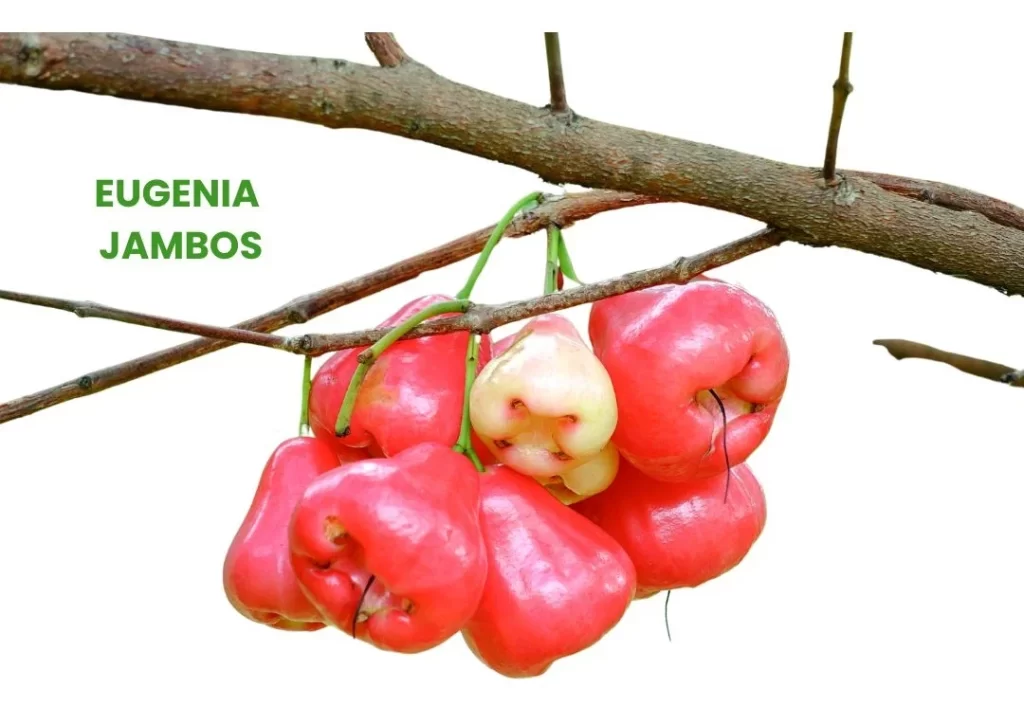Eugenia Jambos, commonly known as Rose-Apple, is a plant used in homeopathy for its unique effects on the body and mind.
Known for producing a state of intoxication similar to alcohol, it has specific applications in treating acne and certain types of headaches.

Table of Contents
ToggleSOURCE INFORMATION
Scientific Classification
- Kingdom: Plantae
- Clade: Angiosperms
- Clade: Eudicots
- Order: Myrtales
- Family: Myrtaceae
- Genus: Syzygium
- Species: S. jambos
Origin and historical facts
- Native Region: Eugenia Jambos is native to Southeast Asia and has been widely cultivated in tropical and subtropical regions around the world.
- Historical Use: Traditionally used for its fruit, which is consumed fresh or used in various culinary dishes.
- In folk medicine, it has been used to treat ailments like diarrhea, coughs, and inflammation.
- Botanical Description: It is a small to medium-sized evergreen tree with a dense canopy and fragrant, white to pale yellow flowers.
- The fruit is round, waxy, and rose-scented.
DRUG PATHOGENESIS
- Eugenia Jambos produces effects similar to alcohol intoxication, where users experience a heightened sense of beauty and size perception, followed by excitement and then depression.
- It has a specific action on the skin, causing acne and pimples that are painful over a considerable area.
KEY CHARACTERISTICS
- Intoxication-like State: Creates a sensation similar to alcohol intoxication.
- Acne Treatment: Effective for different types of acne, including painful and inflamed pimples.
- Nausea Relief: Smoking may alleviate nausea symptoms.
DETAILED ORGAN SYMPTOMS
MIND
- Intoxication: A state resembling alcohol intoxication, with initial excitement followed by depression.
- Perceptions: Everything appears beautiful and larger than normal.
- Talkativeness: Increased desire to talk.
HEAD
- Headache: Sensation as if a board is lying on the right side of the head.
- Eyes: Hot lachrymation (tearing).
SKIN
- Acne: Simple and indurated acne, with painful pimples. Effective for treating acne rosacea.
- Comedones: Presence of blackheads.
- Fissures: Cracks in the skin, particularly around the toes, which can form pus.
- Nail Problems: Skin recedes from the nails, forming pus.
EXTREMITIES
- Nightly Cramps: Cramps in the soles of the feet at night.
- Fissures: Skin cracks and fissures between the toes.
MODALITIES
- Worse: Specific aggravations are not detailed.
- Better: Nausea is improved by smoking.
WHAT ARE MODALITIES IN HOMOEOPATHY?
RELATIONSHIP WITH OTHER DRUGS
Comparisons
- Eugenia Chekun (Myrtus Chekan): Used for chronic bronchitis.
- Antimonium: For respiratory issues and skin conditions.
- Berberis Aquifolium: Used for treating various skin conditions, including acne.
DOSE
- Potency: Typically used in homeopathic potencies according to individual symptoms and practitioner recommendations.
Frequently Asked Questions (FAQs)
What is Eugenia Jambos used for in homeopathy?
- It is primarily used for treating acne, headaches, and nausea, particularly when the nausea is alleviated by smoking.
Is Eugenia Jambos safe?
- When used in homeopathic potencies, it is considered safe.
- However, it should be used under the guidance of a qualified homeopath.
Can Eugenia Jambos treat chronic conditions?
- It may be used to manage symptoms of chronic conditions like acne and certain headaches, but its efficacy can vary among individuals.
Glossary of difficult words
- Indurated: Hardened, particularly in reference to tissue or skin.
- Lachrymation: Tearing or secretion of tears.
- Rosacea: A chronic skin condition that causes redness and visible blood vessels in the face.
- Comedones: Blackheads or whiteheads caused by clogged hair follicles.
Eugenia Jambos, with its unique intoxicating effects and specific skin benefits, serves as a useful remedy in homeopathy for treating acne, headaches, and certain digestive symptoms.
Its efficacy in these areas highlights its importance in homeopathic practice.
